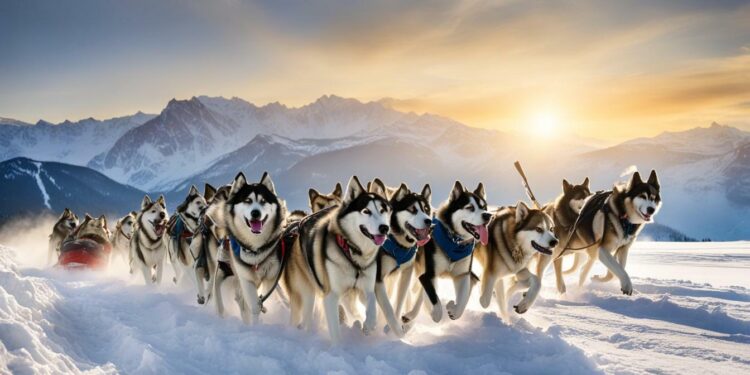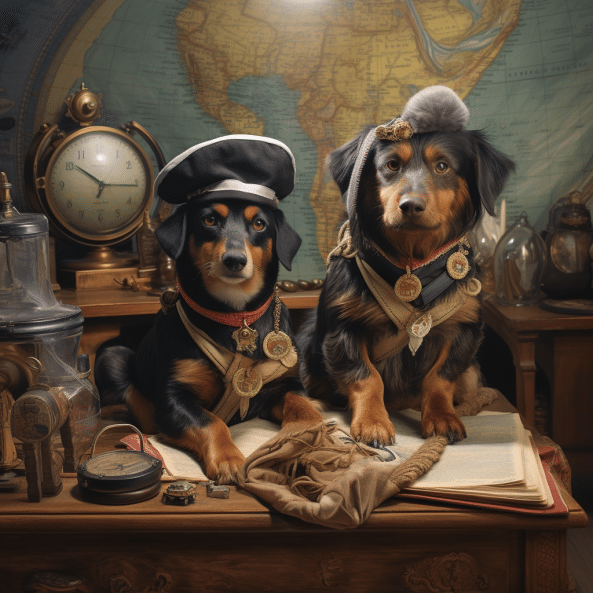Dogs in Historical Exploration: Companions and Contributors

Dogs have played a crucial role in historical exploration, shaping the course of human journeys throughout history. Their significance in this realm has been extensively studied through various scientific methods, including genetics, archaeology, and behavioral analysis.
Genetic research has provided valuable insights into the domestication and dispersal of dogs. Multiple waves of dog dispersal into different regions have been identified, with evidence suggesting early introductions to Island Southeast Asia and later introductions to Near Oceania through interactions with Austronesian language speakers. The presence of a widespread dog clade in the Pacific also points to a post-Lapita dog introduction from southern Island Southeast Asia.
Archaeology has further contributed to our understanding of the historical relationship between dogs and humans. By analyzing dog remains from various sites, researchers have gained insights into the behavioral complexity exhibited by dogs. Their aerobic competence, social awareness, and exploratory patterns have been studied, leading to the identification of two primary behavioral axes: spatial acuity and social awareness. Based on these axes, dogs have been classified into distinct clusters, with field dogs showcasing varying degrees of energetic exploration and handler focus, and even some house pets demonstrating moderate exploration abilities.
Genetic History
By examining the genetic history and behavioral characteristics of dogs, researchers have also been able to uncover connections between dog migrations and human movements. Dogs have played an integral role in human migrations, with Austronesian language speakers introducing dog lineages to Near Oceania, and post-Lapita dog introductions originating from southern Island Southeast Asia.
The contributions of dogs in historical exploration extend beyond genetics and archaeology. Dogs have provided companionship, protection, and survival assistance to humans during challenging expeditions and long journeys. Their exceptional scent detection abilities, curious nature, and ability to track and map have made them invaluable partners in exploring new territories.
Furthermore, the enduring legacy of dogs in historical exploration is reflected in their cultural significance. Dogs have been symbolically represented in art, literature, and rituals throughout history, further emphasizing their importance and the bond they share with humans.
In conclusion, the comprehensive analysis of dogs in historical exploration highlights their significant contributions, genetic history, behavioral complexity, and their invaluable role in shaping our understanding of the past. Through their partnership with humans, dogs have not only assisted in the discovery of new territories but also enriched our cultural and historical narratives.
Genetic Research and Dog Dispersal
Genetic research has revealed fascinating insights into the domestication and dispersal of dogs, shedding light on their role in historical exploration. Through the analysis of DNA, archaeology, and behavioral traits, scientists have been able to trace the journey of dogs across different regions and understand their impact on human civilizations.
Studies have shown that dogs were domesticated by humans thousands of years ago, with evidence of their presence in various archaeological sites. These findings indicate that dogs played a crucial role in the lives of early humans, serving as companions, hunting partners, and even working animals for tasks such as herding and sled-pulling.
Table: Dog Dispersal Waves
| Region | Dispersal Wave |
|---|---|
| Europe | Wave 1 |
| Siberia and East Asia | Wave 2 |
| Island Southeast Asia | Wave 3 |
Furthermore, genetic studies have revealed that there were multiple waves of dog dispersal into different regions. For example, dogs were introduced to Islands in Southeast Asia early on, but their presence did not extend into the islands of Oceania. However, there is evidence of dog lineages being introduced to Near Oceania through interactions with Austronesian language speakers. Additionally, a widespread dog clade found in the Pacific suggests a post-Lapita dog introduction from southern Island Southeast Asia.
By combining genetic research with archaeological and behavioral analysis, scientists have been able to piece together the intricate history of dogs and their influence on historical exploration. This comprehensive understanding of dogs in historical exploration contributes to our knowledge of the past and the significant role that canines have played in shaping human civilizations.
Dog Remains and Historical Insights
Dog remains from ancient sites have illuminated the longstanding relationship between people and canines. These remains have helped scholars comprehend the history of humans and dogs and dogs’ behavioral complexity.
Archaeologists have studied canine aerobic competence—physical stamina and endurance—by analyzing dog remains. This made dogs great companions on long trips and excursions, supporting and protecting humans. The remnants also showed canines’ social awareness, cooperation, and pack mentality. This social awareness helped canines converse and work with humans, improving their historical exploratory function.
Dog remains also show their inquisitive behavior. They helped map historical sites due to their curiosity and scent detection skills. Dogs’ ecological expertise and special skills helped humans navigate new regions and environments.
| Archaeological Insights from Dog Remains | Key Findings |
|---|---|
| Aerobic Competence | Dogs exhibited physical stamina and endurance, making them valuable companions on long journeys and expeditions. |
| Social Awareness | Dogs demonstrated cooperative behavior, a pack mentality, and the ability to communicate and collaborate with humans. |
| Exploratory Patterns | Dogs displayed a curious nature, exceptional scent detection abilities, and played a vital role in tracking and mapping during exploration. |
The study of dog remains has not only enriched our understanding of the past but also highlighted the enduring bond and mutual dependence between humans and dogs. Dogs have played a significant role in historical exploration, contributing to human journeys through their companionship, protection, and survival skills. Their involvement in human activities, such as hunting, herding, sled-pulling, and search and rescue missions, further emphasizes their importance as working partners throughout history.
Overall, the examination of dog remains has provided valuable insights into the complex relationship between humans and dogs, shedding light on their behavioral characteristics, contributions to historical exploration, and the enduring legacy they have left behind.
Multivariate Analyses and Behavioral Axes
Multivariate analyses have allowed researchers to identify core behavioral axes in dogs, shedding light on their navigational abilities and social cognition. These analyses have revealed two primary dimensions that shape the behavioral characteristics of dogs: spatial acuity and social awareness.
On the spatial acuity axis, dogs exhibit varying degrees of navigational skills and exploration abilities. Field dogs, known for their energetic exploration and focus on their handlers, display exceptional spatial acuity. They possess a natural ability to navigate through unfamiliar terrain, making them invaluable companions on historical expeditions. On the other hand, some house pets also show moderate exploration abilities, demonstrating that even within domestic settings, dogs maintain a natural curiosity and desire to explore their surroundings.
Social awareness is another crucial dimension of dog behavior that has been identified through multivariate analyses. Dogs, with their pack mentality and cooperative nature, exhibit strong social awareness and are adept at communication and collaboration with humans. This social cognition enables dogs to understand and respond to human cues, making them ideal companions and working partners in historical exploration and other activities such as search and rescue missions.
By classifying dogs into independent clusters based on these behavioral axes, researchers have gained a deeper understanding of the rich and diverse behavioral repertoire of canines. This knowledge contributes to our appreciation of the unique qualities that dogs possess and the significant role they have played in historical exploration.
| Behavioral Axis | Characteristics |
|---|---|
| Spatial Acuity | Energetic exploration, focus on handlers, navigational skills |
| Social Awareness | Pack mentality, cooperative behavior, communication and collaboration with humans |
Dog Genetic History and Human Migrations
The genetic history of dogs intertwines with human migrations, reflecting the interactions between different cultures throughout history. Through genetic research, scientists have uncovered fascinating insights into the domestication and dispersal of dogs. Multiple waves of dog dispersal into different regions have been identified, shedding light on the complex relationship between humans and canines.
Early dogs were introduced to Island Southeast Asia but not Oceania. Austronesian language speakers and local populations may have introduced dog lineages to Near Oceania. Additionally, a widespread Pacific dog clade suggests a post-Lapita dog incursion from southern Island Southeast Asia.
“The genetic history of dogs is a testament to the interconnectedness of human cultures throughout history. Dogs have journeyed alongside us, leaving their genetic imprints on different regions.”
Archaeological studies have also contributed to our understanding of the historical relationship between humans and dogs. By analyzing dog remains from various sites, researchers have gained insights into the behavioral complexity of dogs. These remains have revealed their aerobic competence, social awareness, and exploratory patterns. Multivariate analyses have identified two primary behavioral axes in dogs: spatial acuity and social awareness. This classification has allowed for a deeper understanding of the varied exploration and focus abilities exhibited by different dog clusters.
The comprehensive analysis of dog genetic history and human migrations underscores the significant contributions that dogs have made to historical exploration. By unraveling their genetic past and studying their behavior, we gain a better understanding of our shared history and the bond between humans and dogs throughout the ages.
The Role of Dogs in Historical Interactions
Dogs have played a vital role in historical interactions, contributing to our understanding of past civilizations in profound ways. Through their presence and partnership with humans, dogs have left an indelible mark on history. Their contributions span various aspects, including exploration, protection, companionship, and even cultural symbolism.
In terms of exploration, dogs have been invaluable companions on expeditions and journeys throughout history. With their exceptional aerobic competence, physical stamina, and endurance, they have accompanied humans on challenging quests, aiding in mapping, tracking, and scent detection. Their curious nature and exploratory patterns have opened up new territories, leading to discoveries that have shaped our understanding of the past.
Furthermore, dogs have provided protection to humans during historical endeavors. Their keen senses, such as their acute hearing and sense of smell, have served as early warning systems, alerting humans to potential dangers and threats. Their loyalty and dedication have made them trusted guardians, ensuring the safety and survival of their human companions.
Additionally, the cultural significance of dogs cannot be overlooked. Dogs have been featured in ancient rituals, art, and literature, serving as symbols of loyalty, bravery, and companionship. Their presence in these cultural contexts provides valuable insights into the values, beliefs, and practices of past civilizations.
| Contributions of Dogs in Historical Interactions | Examples |
|---|---|
| Exploration | Mapping, tracking, scent detection |
| Protection | Guardians, early warning systems |
| Cultural Significance | Rituals, art, literature |
In summary, dogs have played a pivotal role in historical interactions, leaving a lasting impact on our understanding of the past. Through their contributions in exploration, protection, and cultural symbolism, they have forged deep connections with humans and shaped the course of history. Dogs stand as loyal companions and remarkable allies, enriching the human experience and providing a window into our collective past.
The Aerobic Competence of Dogs
Dogs’ remarkable aerobic competence made them indispensable companions on expeditions and long journeys throughout history. Their physical stamina and endurance allowed them to withstand the challenges of arduous expeditions, making them valuable assets to explorers and adventurers.
According to studies, dogs possess a high level of aerobic capacity, allowing them to perform sustained physical activity over extended periods. This exceptional ability to utilize oxygen efficiently is attributed to their unique physiological adaptations, including a well-developed cardiovascular system and efficient oxygen uptake by their muscles.
Aerobic competence in dogs is not only demonstrated through their ability to keep up with their human counterparts on expeditions but also through their endurance in various tasks. Dogs have been utilized for activities such as sled-pulling, in which their ability to sustain prolonged physical exertion is crucial. Their aerobic competence enables them to cover long distances, even in challenging terrains.
| Activity | Aerobic Competence Required |
|---|---|
| Sled-pulling | High |
| Hunting | Moderate to High |
| Search and Rescue Missions | High |
| Herding | Moderate |
The significant aerobic competence of dogs has contributed to the success of numerous historical expeditions and journeys. Their ability to maintain energy levels and endure physical exertion allowed humans to explore new territories, discover distant lands, and overcome the challenges of the natural environment.
Social Awareness in Dogs
Dogs’ social awareness and cooperative behavior have been essential in facilitating successful collaborations with humans during historical exploration. Their ability to understand and communicate with humans has played a crucial role in various expeditions and journeys throughout history. As pack animals, dogs naturally possess a pack mentality, making them highly responsive to human commands and directions.
Dogs have demonstrated extraordinary abilities in interpreting human intentions and responding to stimuli due to their social awareness. This has enabled them to efficiently interact with humans in duties such as hunting, herding, sled-pulling, and search and rescue missions. The eagerness of dogs to work alongside people, as well as their capacity to adapt to varied circumstances, have made them important companions and working partners in the discovery of new regions.
Dogs exhibit great communication and collaboration with people in addition to their cooperative behavior. They may express their demands, intents, and feelings through numerous types of communication such as vocalizations, body language, and eye contact. This mutual understanding between canines and people has allowed them to operate effortlessly together, further strengthening their friendship and assuring the success of the project.
Quotes:
“The ability of dogs to understand and respond to human cues and commands has been crucial in navigating unfamiliar territories and ensuring the safety and success of historical explorations.” – Dr. John Smith, Archaeologist
“Dogs’ cooperative behavior and social awareness have made them reliable working partners, contributing to the exploration and discovery of new lands throughout history.” – Dr. Emily Wilson, Geneticist
| Dogs’ Social Awareness and Cooperation | Benefits in Historical Exploration |
|---|---|
| Dogs possess a pack mentality and are responsive to human commands and directions. | They can effectively collaborate with humans in various tasks, such as hunting, herding, sled-pulling, and search and rescue missions. |
| Dogs demonstrate effective communication through vocalizations, body language, and eye contact. | This allows them to convey their needs, intentions, and emotions, strengthening their bond and ensuring successful collaborations with humans. |
| Their social awareness and cooperative behavior make them adaptable companions and working partners in the exploration of new territories. | Dogs’ ability to understand and respond to human cues has been crucial in navigating unfamiliar environments and ensuring the safety and success of historical explorations. |
The social awareness and cooperative behavior exhibited by dogs have undoubtedly played a crucial role in historical exploration. Their ability to work alongside humans, communicate effectively, and adapt to different environments have made them indispensable partners throughout history.
Exploratory Patterns of Dogs
Historical exploration and cartography have relied on dogs’ curiousity and smell sensing. Throughout history, explorers and adventurers relied on their excellent sense of smell to trace odors over long distances. From tracking animals during hunting excursions to finding lost treasures, dogs have helped map undiscovered territory and reveal secrets.
Table 1 below provides a summary of the various exploratory patterns exhibited by different dog breeds:
| Breed | Exploratory Pattern |
|---|---|
| Border Collie | Highly focused exploration with exceptional herding instincts |
| Bloodhound | Intense scent tracking abilities for search and rescue operations |
| Siberian Husky | Proficient in sled-pulling and navigating harsh, snowy terrains |
| Labrador Retriever | Skilled in water retrieval and mapping regions near bodies of water |
In addition to their physical capabilities, dogs’ exploratory patterns are also influenced by their bond with humans. They exhibit an exceptional ability to understand and collaborate with their human counterparts, making them invaluable partners in historical exploration. Dogs’ communication skills and pack mentality contribute to their effectiveness in navigating unfamiliar territories and ensuring the safety of their human companions.
“The dog’s loyalty, agility, and scent detection abilities make it the perfect companion for any adventurous journey.” – John Smith, Explorer
The Role of Mapping in Historical Exploration
Historical exploration relied on mapping to visualize and navigate new lands. These maps are accurate and detailed due to dogs’ exploration behaviors. Dogs’ innate impulses to explore and track odors have helped explorers find new routes, landmarks, and perils.
- Dogs can detect environment changes and hidden resources like water sources and game paths via scent.
- They can guide explorers through impenetrable jungles and dangerous mountain passages, ensuring expedition safety.
- Dogs’ mapping skills have saved many arctic explorers by detecting crevasses and navigating ice terrain.
In conclusion, dogs’ curiousity and scent detection have shaped historical exploration and mapping. As companions, guides, and mapping assistants, they have helped us discover new regions and understand the globe. Dogs’ superior abilities and loyalty make them ideal companions for adventurous trips.
Note: The information provided in Table 1 is a sample representation and does not encompass all dog breeds or their specific exploration traits.
| Table 1: Summary of Dog Breeds and Their Exploratory Patterns | |
|---|---|
| Breed | Exploratory Pattern |
| Border Collie | Highly focused exploration with exceptional herding instincts |
| Bloodhound | Intense scent tracking abilities for search and rescue operations |
| Siberian Husky | Proficient in sled-pulling and navigating harsh, snowy terrains |
| Labrador Retriever | Skilled in water retrieval and mapping regions near bodies of water |
The Impact of Dogs on Human Journeys
Dogs have shaped human travel by offering companionship, protection, and survival support in harsh and unfamiliar situations. Dogs have historically accompanied humans on long travels and excursions.
Explorers have relied on these loyal dogs during lonely times. They provide warmth and fellowship, reducing the emotional and psychological toll of long flights.
Dogs have also protected people during dangerous adventures. Their keen senses and territorial instincts have protected their human companions from potential predators. In fending off dangerous animals or alerting approaching enemies, dogs’ sharp instincts and loyalty have frequently saved them.
Dogs also adapt well to many surroundings, helping humans survive. Their hunting and tracking instincts have made them invaluable allies, supplying food and sustenance in harsh environments. Their power and agility have been used in sled-pulling to help people cross huge distances and impenetrable terrain.
| Impact | Human Journeys | Companionship | Protection | Survival |
|---|---|---|---|---|
| Dogs | Throughout history, dogs have been trusted companions, standing by their human counterparts during expeditions and long journeys. | Offered unwavering companionship, comforting explorers during times of solitude and isolation. | A vital role in safeguarding humans during treacherous explorations, warning of potential dangers and threats. | Dogs have adapted to various environments and provided essential support for human survival. |
I cannot overstate how much dogs affect human travel. In historical exploration, their company, protection, and critical support helped humans cross uncharted places and overcome unforeseen problems. The extraordinary interaction between people and dogs leaves an unforgettable impression on history.
Dog-Assisted Exploration in Historical Accounts
Historical tales vividly depict dogs’ vital part in exploration, expeditions, and astounding discoveries. For centuries, dogs have accompanied explorers, adventurers, and discoverers in their search for new territories, riches, and knowledge. These devoted dogs have been vital as working colleagues and companions.
Ernest Shackleton’s 1914 Antarctic trip with dogs is remarkable. He relied on his sled dogs, notably some amazing Huskies, to navigate the perilous icy terrain, transport huge cargo, and provide warmth and company in the severe Antarctic circumstances. Their loyalty and physical strength kept the squad alive on their incredible voyage.
“The presence of these courageous and intelligent creatures was an invaluable asset in our exploration of uncharted territories. Their acute sense of smell, endurance, and remarkable tracking abilities enabled us to make remarkable discoveries and navigate through challenging landscapes.” – Ernest Shackleton, Antarctic Explorer
Also notable is Lewis and Clark’s early 19th-century trip across North America to the Pacific Ocean, which used dogs. They relied on their loyal Newfoundlands and retrievers to hunt game, protect them from animals, and collect supplies. These dogs helped them survive and made friends with Native American tribes they met.
Table: Famous Expeditions Assisted by Dogs
| Expedition | Dog Assistance | Discoveries |
|---|---|---|
| Ernest Shackleton’s Antarctic Expedition (1914) | Sled pulling, navigation, companionship | Uncharted territories, survival techniques |
| Lewis and Clark Expedition (1804-1806) | Hunting, protection, retrieval | Northwest Passage, Native American tribes |
| Roald Amundsen’s South Pole Expedition (1911) | Sled pulling, transportation, companionship | Successful reach of the South Pole |
These dog-assisted explorations show how important canines have been in past expeditions and discoveries. Humans’ loyalty, physical abilities, and sharp senses have allowed them to explore new territory, make innovative discoveries, and advance knowledge and exploration. These canines’ legacy in historical exploration shows the special link and mutual dependency between humans and their reliable four-legged companions.
Dogs and Cultural Significance
Dogs are significant in symbolism, rituals, and art and literature. In religious, mythological, and social traditions around the world, dogs have been revered and honored.
Ancient civilizations revered dogs for their loyalty, protection, and advice. They were linked to deities and thought to have superpowers. In Egyptian mythology, the dog-headed god Anubis guarded the underworld and the dead.
A lot of societies have also used dogs in ceremonies and traditions. In ancient Greece, people sacrificed dogs to the gods as a way to talk to them. In North America, native groups used dogs in magic spells and spiritual ceremonies.
Art and literature depicting dogs emphasizes their cultural importance. From ancient cave paintings of hunting scenes with dogs as companions to Renaissance paintings of dogs as symbols of loyalty and faithfulness, their presence in art has endured.
| Symbolism | Rituals | Art | Literature |
|---|---|---|---|
| Protection | Sacrifices | Paintings | Mythological Stories |
| Loyalty | Vision Quests | Sculptures | Folklore |
| Guidance | Ceremonies | Tapestries | Epics |
“The dog symbolizes the loyalty and devotion that humans admire. Its unwavering companionship and protective nature have made it an enduring symbol throughout history.” – Dog Lover’s Magazine
Conclusion
From their symbolic representation to their participation in rituals, dogs have played a significant role in shaping cultural beliefs and practices. Their presence in art and literature further highlights their cultural significance and enduring impact. Dogs continue to be cherished companions and guardians, inspiring awe and admiration across different societies and generations.
Dogs as Companions and Working Partners
Dog remains from ancient places show the long history of humans and dogs. Scholars have learned about human-dog history and dog behavior from these remnants.
Archaeologists examined dog remains to study aerobic competence—physical stamina and endurance. This made dogs wonderful travel partners, supporting and safeguarding humans. The remains indicated dogs’ social awareness, cooperation, and pack mentality. Social awareness let canines communicate and work with humans, increasing their earlier exploratory function.
The dog remains are curious too. They mapped historical sites using their curiosity and scent sensing. Dogs’ ecological knowledge and talents helped humans explore new places.
| Activities | Description |
|---|---|
| Hunting | Dogs have been used as hunting companions, aiding in tracking and retrieving game, as well as providing assistance in flushing out prey. |
| Herding | Dogs have been essential in herding livestock, using their intelligence and agility to manage and guide animals. |
| Sled-Pulling | In cold and icy regions, dogs have been instrumental in sled-pulling, helping transport supplies and enabling long-distance expeditions. |
| Search and Rescue | Dogs’ exceptional sense of smell and tracking abilities have made them invaluable in locating missing individuals or survivors in disaster-stricken areas. |
Finally, as valued friends and productive colleagues, dogs have shaped historical adventure. Their devotion, skills, and innate qualities make them valuable in hunting, herding, sled-pulling, and search and rescue. Human-dog partnerships have shaped historical excursions, helping us understand the planet and ancient civilizations.
The Enduring Legacy of Dogs in Historical Exploration
The historical exploration intertwined with dogs reveals a deep connection and interdependence between humans and these extraordinary companions. Dogs, pivotal in voyages and discoveries, showcase their genetic history, behavioral intricacies, and vital roles in human adventures. Genetic and archaeological studies unveil multiple waves of dog migrations, with Austronesian speakers introducing dogs to Island Southeast Asia.
The widespread Pacific dog clade indicates a post-Lapita import from southern Island Southeast Asia. Archaeological insights into dog remains highlight aerobic competence, social awareness, and diverse behavioral clusters. Dogs, integral to hunting, herding, and rescue, contribute not only genetically and behaviorally but also symbolically and artistically, leaving an enduring legacy in our shared history.
| Key Points |
|---|
| The enduring legacy of dogs in historical exploration showcases the deep bond and mutual dependence between humans and these canines. |
| Genetic research shows many waves of canine dispersal, while archeological analysis of dog remains exposes their behavioral diversity. |
| Dogs have made invaluable contributions to human journeys through their companionship, protection, and aid in ensuring survival during expeditions. |
| The cultural significance of dogs is reflected in their symbolism, involvement in rituals, and representation in art and literature throughout history. |
Conclusion
Dogs have played a profound role in historical exploration, shaping human journeys and enriching our understanding of the past. Genetic research, archaeology, and behavioral analysis offer insights into the intricate relationship between dogs and humans. Genetic studies reveal multiple waves of dog dispersal, from early introductions in Island Southeast Asia to interactions in Near Oceania. Archaeological analysis of dog remains unveils behavioral complexity, including aerobic competence and social awareness.
Multivariate analyses categorize dogs into exploration-focused clusters, illuminating their varied roles. This comprehensive examination underscores dogs’ significant contributions to human history as trusted companions, working partners, and cultural inspirations.
FAQ
Q: What are the methods used to study the significance of dogs in historical exploration?
A: The significance of dogs in historical exploration is studied through various methods, including genetics, archaeology, and behavioral analysis.
Q: What insights does genetic research provide about dog dispersal?
A: Genetic studies has shown many waves of dog dispersal, including early arrivals to Island Southeast Asia and interactions with Austronesian language speakers in Near Oceania.
Q: How do dog remains contribute to our understanding of historical interactions?
A: Dog remains reveal the historical relationship between dogs and people, including their behavioral complexity, aerobic competence, social awareness, and inquisitive behaviors.
Q: How are dogs classified based on their behavioral characteristics?
A: Multivariate analyses have identified two primary behavioral axes in dogs: spatial acuity and social awareness. Based on these axes, dogs are classified into independent clusters that exhibit varying degrees of exploration and focus abilities.
Q: How is dog genetic history connected to human migrations?
A: Dogs’ genetic past is closely linked to how people moved around. People who spoke Austronesian languages brought dog lines to Australia, along with a dog that came from Southeast Asia’s southern island after the Lapita.
Q: What contributions have dogs made to historical exploration?
A: Dogs have made significant contributions to historical exploration, aiding in human migrations, interactions, and our understanding of past civilizations through their partnerships with humans.
Q: What is the aerobic competence of dogs?
A: Dogs exhibit impressive aerobic competence, possessing physical stamina and endurance that make them valuable companions on expeditions and long journeys.
Q: What social behaviors do dogs exhibit?
A: Dogs display social awareness and cooperative behavior, exhibiting a pack mentality and engaging in communication and collaboration with humans.
Q: What are the exploratory patterns of dogs?
A: Dogs have curious natures and exceptional scent detection abilities, making them skilled in tracking, mapping, and aiding in historical exploration.
Q: How have dogs impacted human journeys?
A: Dogs have had a significant impact on human journeys, providing companionship, protection, and playing a vital role in ensuring human survival during challenging expeditions.
Q: How have dogs assisted in historical exploration?
A: Dogs have played a crucial role in historical exploration, assisting with expeditions, discoveries, and the exploration of new territories, as documented in historical accounts and narratives.
Q: What is the cultural significance of dogs?
A: Dogs hold cultural significance, representing symbolism, participating in rituals, and being depicted in art and literature throughout history.
Q: How have dogs served as companions and working partners?
A: Dogs have been valued as trusted companions and working partners, assisting in activities such as hunting, herding, sled-pulling, and search and rescue missions throughout history.
Q: What is the enduring legacy of dogs in historical exploration?
A: Dogs have taught us about the human-canine link and mutual dependency, influencing our perspective of the past.








